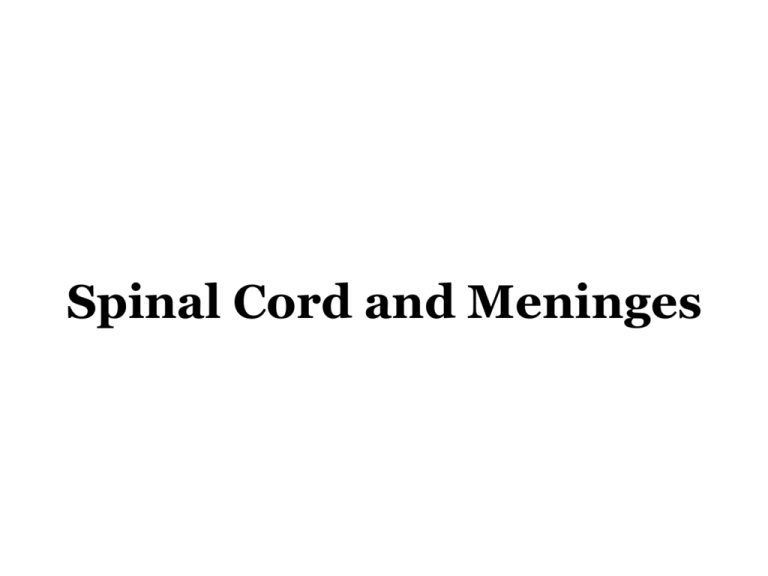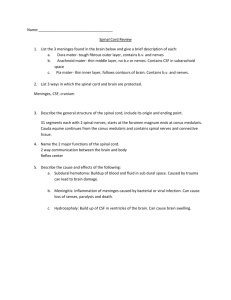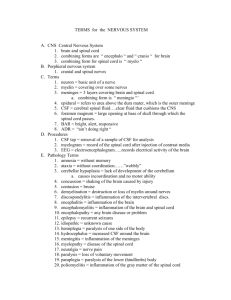Lecture Spinal Cord and Meninges
advertisement

Spinal Cord and Meninges Objectives: 1. Describe the segmental nature and external structure of the spinal cord. 2. Indicate the relationship of spinal roots/nerves to intervertebral discs (what cord levels will be affected with a disc protrusion in cervical or lower lumbar levels?) 3. Describe the blood supply and venous drainage of the spinal cord. 4. Describe the structure of the meninges and the associated spaces. A 18-year-old female presents with pain in her neck and in her right arm. Physical exam reveals pain along the lateral arm, involving the thumb. Grip strength is normal. Her upper limb reflexes on the right side are: • biceps = 1/4 • brachioradialis = 0/4 • triceps = 2/4 What is the most likely etiology for these findings? CLINICAL CONCEPT Muscle Strength is measured on a scale of 0 to 5. > Normal strength is 5/5 > Paralysis is 0/5 Reflexes are measure on a scale of 0 to 4. > Normal is 2/4 > PNS lesions are 0 or 1/4 > CNS lesions are 3 or 4/4 Spinal Cord The spinal cord: • occupies the vertebral canal • in infants the spinal cord extends into the sacrum • in the adult the cord extends from the cranial border of the atlas to L2 • level is slightly higher when the column is flexed Spinal Cord The spinal cord is: • part of the central nervous system. • segmental in nature What is a spinal cord segment? How many segments are there? Note the relationship of the “nerves” to the spinal cord: Dermatomes, Myotomes and Sclerotomes C5 C6 C7 Teres Minor Supraspinatus Rhomboids Infraspinatus Deltoid Teres Major Biceps Brachialis Serratus Anterior Subscapularis Pectoralis Major Pectoralis Minor Coracobrachialis Latissimus Dorsi Anconeus Triceps C8 T1 “The Heavenly Seven” Spinal Cord Enlargements Cervical Enlargement • the larger and more pronounced of the enlargements • extends from about C3 to T2 Lumbar Enlargement • extends from L1 to S3 Below the lumbar enlargement, the cord tapers to the conus medullaris. Nerve Roots Nerve Roots Cauda equina: Nerve Roots and IV Discs Position of spinal segments relative to vertebra • Cervical – tip of the spine corresponds to the succeeding segment (C6 spine = C5 cord level) • Upper Thoracic – tip of the spine corresponds to 2 segments lower in number (T4 spine = T6 segment) • Lower Thoracic – 3 segments difference (T10 spine = L1 segment) A 43-year-old female presents with abdominal pain of gradual onset. Physical exam reveals a non-tender, pulsating mass on the left side of the abdomen. An MRI and angiography reveals an aortic aneurysm. She elects for surgical repair. Physical exam following the surgery reveals on the left: a hypoactive patellar reflex [1/4] and weakness in the quadriceps [3/5]. What happened? artery of Adamkiewicz is blocked Blood Supply to the Spinal Cord • Branches from the Vertebral Artery – 1 Anterior and 2 Posterior Spinal Arteries • Feeder Vessels – highly variable; artery of Adamkiewicz (lumbar) • Radicular arteries – supply the roots Blood Supply to the Spinal Cord Spinal arteries Postcentral Radicular arteries = supply the dorsal and ventral roots, some branches (feeder vessels) join the anterior and posterior spinal arteries Prelaminar Blood Supply to the Spinal Cord Venous Drainage of the Spinal Cord Spinal Veins: Internal Venous Plexus: Intervertebral veins: Venous Drainage of the Spinal Cord External Spinal Venous Plexus: Basivertebral Veins: Venous Drainage of the Spinal Cord BATSON’S PLEXUS *Know 2 facts…see notes below Spinal Meninges The spinal cord (in fact the entire CNS) is enclosed in three layers of tissue, the meninges. The meninges are from external to internal: 1. Dura mater 2.Arachnoid mater 3.Pia mater Spinal Meninges The dura mater: • is the outermost covering of the spinal cord. • is a thick and dense inelastic membrane • forms a loose sheath around the cord • attaches around the foramen magnum and to the bodies of the 2nd and 3rd cervical vertebrae • has tubular extensions for the roots of the spinal nerve as they pass thorough the IV foramen Spinal Meninges Epidural space: • between the dura and the periostium of the vertebrae • fluids put into the sacral hiatus can spread to the base of the skull Subdural space: • potential space between dura and the arachnoid that contains only a serous fluid • the arachnoid is not attached to the dura, but held to it by the normal pressure of CSF • ends at the level of S2 Spinal Meninges The arachnoid is a delicate membrane, that is separated from the dura by a potential subdural space. Subarachnoid space: A REAL SPACE, NOT A POTENTIAL SPACE! • between the arachnoid and the pia • contains cerebrospinal fluid (CSF), blood vessels and connective tissue • surrounds the cord and spinal nerves, ends at the level of S2 Spinal Meninges The arachnoid is only loosely related to the underlying pia mater. • the spinal cord ends at L2 • the dural sac and arachnoid end at S2 As a result there is a large space between the arachnoid and pia in the lumbar region: Lumbar Cistern: Go below L3 w/needle, which will push nerve roots out of the way and will penetrate the subarachnoid space to get a CSF sample. Sampling CSF: Lumbar puncture and intracranial pressure:What about a newborn? Extends into sacrum in newborn. Lumbar Cistern Lumbar Puncture Spinal Meninges The pia mater: • faithfully invests the spinal cord and brain • is a vascular membrane • Contains denticulate ligaments, delicate little transparent-like tissue that look like teeth coming off. ..see next slide. Spinal Meninges Denticulate ligaments: • continuous with the pia on the cord, between the dorsal and ventral roots • tooth-like process, 21 in number, stops at the T12 level • serves to stabilize the cord within the dura Spinal Meninges The filum terminale: • is a fine filament of pia and connective tissue that descends from the conus medullaris • descends to the level of S2 where it is joined by dura (filum terminale internum) • descends to coccygeal levels and anchors the spinal cord in the dura sac (filum terminale externum) Spinal Meninges Spinal block: Epidural block: Spinal Meninges








